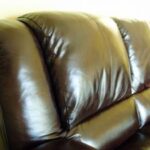Shopping for leather furniture can be exciting, but it can also be very confusing. There are so many different types of leather, and a lot of misinformation floating around. By going into the experience with a little knowledge about leather and its use on furniture, you can more easily locate the right leather furniture piece for you.
Types and Finishes in Leather Furniture
There are words and jargon that get used by sales people and stores that may confuse you. Know what they are talking about and that is half the battle.
Top Grain Leather: Leather is not just a cowhide. It is the hide split into layers. The layer to the outside of the animal is the top. If your piece of furniture is top grain leather, you are getting that part. It is the most durable of the leathers. Split Leather is the other parts of the leather and is not nearly as durable or soft.
Analine finish is when leather is soaked in a clear dye. It is basically a finish that will help to make the leather more cleanable. Remember that leather is skin and if left untreated it will absorb everything. Semi-analine leather finish has a smaller amount of dye used on it. It gives it a little bit of protection, but not as much as a full analine finish does.
Pigmented finishes are on colored leather. The leather is fully treated with surface color and usually is with lower grade leather. They are the best in terms of resisting scratches and tears as well as stains. On the downside, they are less comfortable and tend to be fairly stiff.
Nubuck leather has minimal treatment and is generally very soft. However, furniture made of nubuck will be very susceptible to stains. It will also develop a pantina on it over time from the oils in your body and from the day to day use of it like a bomber jacket might.
Pull-up leather is heavily treated with oil or wax. It is easy to recognize since the wax and oil separate when the leather is stretched at all. This will produce a lighter color and distressed look from the day-to-day use of it. Pull-up leather does tend to be “slippery,” though.
Leather Matches
You will often see or hear the phrase “leather match” with furniture. What that means is that everywhere you sit on and touch (the seat, tops of the arms, foot rests, etc.) are actually leather. The rest of the piece (sides and back) is something else. In most cases, the “something else” is a matching vinyl. Some furniture, though, will have a top grain leather matched with a split of some kind.
A leather match is often more affordable and will give you that feel you are looking for in leather. You have to decide for yourself whether or not it is worth it to sacrifice the durability of the rest of the piece. Also, some matches are better than others; so take a good look at how well the colors seem to match up.
Variances in Pieces
You have to remember that leather comes from an animal. That means that no two pieces are exactly alike. A heavily embossed or dyed piece will be more likely to be consistent, but scars and bites on the animals and even dye lots will affect the look from piece to piece. If you see something on a show floor, it is important that you realize the “new” one you get from the warehouse may be a little different.
Cut and Sew
You may here the phrase “cut and sew” when dealing with leather furniture. It is mostly an industry term, but it is best to know where your furniture comes from and how it made.
Leather comes from all over the world. The United States, Canada, China, and South America among other regions produce leather. Some are able to do so cheaper than others. There are some quality differences, but the grade and type of leather is usually more important than its country or region of origin.
In contrast, many of the frames for furniture from American companies are made in the United States. In a cut and sew situations, the leather is made in another country (often china) as well as treated and sewn into the proper size and shape to be put on the frames. The cut and sews covers are then shipped to the US factory where the leather is put over the frame of the sofa. This is a way that manufacturers can keep costs down and still claim the piece is made in the USA.
Once you have made your decision and you have your new leather furniture at home, you should be proud. It is something that can last you a lifetime, but only if you properly care for it.
– Dryness is the enemy of your leather furniture, and it can make it brittle. Keep it
– away from heat sources as much as possible.
– Keep your leather furniture out of direct sunlight. The sunlight can cause your leather furniture to fade out.
– Dust your leather furniture regularly. Keeping it clean will go a long way in keeping it durable and lasting.
– If you do happen to spill on your leather furniture, blot the spill immediately with a dry absorbent cloth. Then, allow it to air-dry. – Use leather cleaners or creams regularly to keep it soft and to help it resist stains.
If you follow these tips, you will find that your leather furniture will be a sound investment that will last you a lifetime.
Shopping for leather furniture can be a bit daunting. However, if you educate yourself just a little on what leather furniture is all about, and familiarize yourself with the jargon, you will find that you will be able to make a decision that will enhance your home for years to come.




